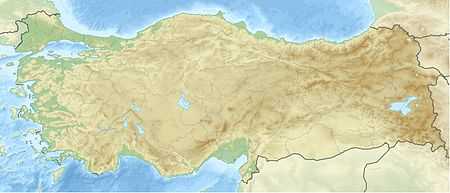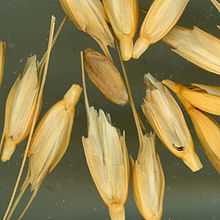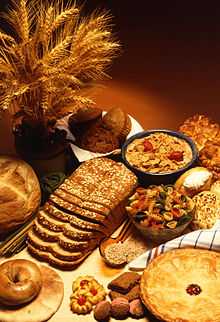Einkorn wheat
| Einkorn wheat | |
|---|---|
 | |
| Scientific classification | |
| Kingdom: | Plantae |
| (unranked): | Angiosperms |
| (unranked): | Monocots |
| (unranked): | Commelinids |
| Order: | Poales |
| Family: | Poaceae |
| Genus: | Triticum |
| Species: | T. monococcum |
| Binomial name | |
| Triticum monococcum L. | |

Einkorn wheat (from German Einkorn, literally "single grain") can refer either to the wild species of wheat, Triticum baeoticum, or to the domesticated form, Triticum monococcum. The wild and domesticated forms are either considered separate species, as here, or as subspecies: Triticum monococcum subsp. baeoticum (wild) and T. monococcum subsp. monococcum (domesticated). Einkorn is a diploid species (2n = 14 chromosomes) of hulled wheat, with tough glumes ('husks') that tightly enclose the grains. The cultivated form is similar to the wild, except that the ear stays intact when ripe and the seeds are larger.
Einkorn wheat was one of the first plants to be domesticated and cultivated. The earliest clear evidence of the domestication of Einkorn dates from 10,600 to 9,900 years before present (8,650 BC to 7,950 BC) from two archaeological sites in southern Turkey.[1]
History
| Karaca Dağ | |
|---|---|
 Karaca Dağ | |
| Location | |
| Coordinates | 37°40′12″N 39°49′48″E / 37.67000°N 39.83000°ECoordinates: 37°40′12″N 39°49′48″E / 37.67000°N 39.83000°E |
Einkorn wheat commonly grows wild in the hill country in the northern part of the Fertile Crescent and Anatolia although it has a wider distribution reaching into the Balkans and south to Jordan near the Dead Sea. It is a short variety of wild wheat, usually less that 70 centimetres (28 in) tall and is not very productive of edible seeds. The principle difference between wild einkorn and cultivated einkorn is the method of seed dispersal. In the wild variety the seed head usually shatters and drops the kernels (seeds) of wheat onto the ground. This facilitates a new crop of wheat. In the domestic variety, the seed head remains intact. Human intervention caused the difference. Harvesting einkorn with intact seed heads was easier for early human harvesters. Thus, over time and through selection, conscious or unconscious, the human preference for intact seed heads created the domestic variety, which also has slightly larger kernels than wild einkorn. Domesticated einkorn requires human planting and harvesting for its continuing existence.[2] This process of domestication might have taken only 20 to 200 years with the end product a wheat easier for humans to harvest.[3]

Einkorn wheat is one of the earliest cultivated forms of wheat, alongside emmer wheat (T. dicoccum). Grains of wild einkorn have been found in Epi-Paleolithic sites of the Fertile Crescent. Although gathered from the wild for thousands of years, Einkorn Wheat was first domesticated approximately 10,000 years BP in the Pre-Pottery Neolithic A (PPNA) or B (PPNB) periods.[4] Evidence from DNA finger-printing suggests einkorn was first domesticated near Karaca Dağ in southeast Turkey, an area in which a number of PPNB farming villages have been found.[5]
An important characteristic facilitating the domestication of einkorn and other annual grains is that the plants are largely self-pollinating. Thus, the desirable (for human management) traits of einkorn could be perpetuated at less risk of cross-fertilization with wild plants which might have traits—e.g. smaller seeds, shattering seed heads, etc. -- less desirable for human management.[6]
From the northern part of the Fertile Crescent, the cultivation of einkorn wheat spread to the Caucasus, the Balkans, and central Europe. Einkorn wheat was more commonly grown in cooler climates than emmer wheat, the other domesticated wheat. Cultivation of einkorn in the middle east began to decline in favor of emmer wheat around 2000 BC. Cultivation of einkorn was never extensive in Italy, southern France, and Spain. Einkorn continued to be cultivated in some areas of northern Europe throughout the middle ages and until the early part of the 20th century. Einkorn wheat is low-yielding but can survive on poor, dry, marginal soils where other varieties of wheat will not. It is primarily eaten boiled in whole grains or in porridge. Its flour lacks the rising characteristics desirable for bread.[7]
Einkorn, as with other ancient varieties of wheat, is grouped with "the covered wheats" as its kernels do not break free from its seed coat (glume) with threshing and it is, therefore, difficult to separate the husk from the seed. Einkorn today it is a relict crop that is rarely planted, though it has found a new market as a health food. It remains as a local crop, often for bulgur (cracked wheat) or as animal feed, in mountainous areas of France, India, Italy, Morocco, the former Yugoslavia, Turkey and other countries.[8]
Nutrition and gluten toxicity
Einkorn has a higher percentage of protein than modern red wheats and is considered more nutritious because it has also higher levels of fat, phosphorus, potassium, pyridoxine, and beta-carotene.[9]
In contrast with more modern forms of wheat, evidence suggests the gliadin protein of einkorn may not be as toxic to sufferers of coeliac disease.[10] It has yet to be recommended in any gluten-free diet.
Salt-tolerance gene
Australian scientists have succeeded in breeding the salt-tolerance feature of T. monococcum into durum wheat.[11]
References
- ↑ Weiss, Ehud and Zohary, Daniel (October 2011), "The Neolithic Southwest Asian Founder Crops: Their Biology and Archaeobotany", Current Anthropology, Vol 52, No. S4, pp. S239-S240. Downloaded from JSTOR
- ↑ Weiss and Zohary, p. S239-S242
- ↑ Anderson, Patricia C. (1991), "Harvesting of Wild Cereals During the Natufian as ween from Experimental Cultivation and Harvest of Wild Einkorn Wheat and Microwear Analysis of Stone Tools", In Natufian Culture in the Levant ed. by Ofer Bar-Yosef, Ann Arbor:International Monographs in Prehistory. p. 523
- ↑ Hopf, M.; Zohary, D. (2000). Domestication of Plants in the Old World: The Origin and Spread of Cultivated Plants in West Asia, Europe, and the Nile Valley (3rd ed.). Oxford, Oxfordshire: Oxford University Press. p. 38. ISBN 0-19-850356-3.
- ↑ Heun, M.; Schäfer-Pregl, R.; Klawan, D.; Castagna, R.; Accerbi, M.; Borghi, B.; Salamini, F. (1997). "Site of Einkorn Wheat Domestication Identified by DNA Fingerprinting". Science 278 (5341): 1312–1314. doi:10.1126/science.278.5341.1312.
- ↑ Bellwood, Peter (2005), First Farmers: The Origins of Agricultural Societies, Malden, MA: Blackwell Publishing, pp. 46-49
- ↑ Zohary and Hopf, pp. 33-43
- ↑ Stallknecht, G. F., Gilbertson, K. M., and Ranney, J.E. (1996), "Alternative Wheat Cereals as Food Grains: Einkorn, Emmer, Spelt, Kamut, and Triticale" in J. Janick (ed, Progress in New Crops, Alexandria, VA: ASHA Press, pp. 156-170
- ↑ Stallknecht, et al. pp. 156-170
- ↑ Pizzuti, D.; Buda, A.; d'Odorico, A.; d'Incà, R.; Chiarelli, S.; Curioni, A.; Martines, D. (2006). "Lack of intestinal mucosal toxicity of Triticum monococcum in celiac disease patients". Scandinavian Journal of Gastroenterology 41 (11): 1305–1311. doi:10.1080/00365520600699983. PMID 17060124.
- ↑ "World Breakthrough On Salt-Tolerant Wheat". ScienceDaily. March 11, 2012.
External links
| Wikimedia Commons has media related to Triticum monococcum. |
- Ancient Grain Varieties in Archaeology
- Wheat evolution: integrating archaeological and biological evidence
| |||||||||||||||||||||||||||||||||||||||||||||
| ||||||||||||||||||||||||||||||||||||||||||||||||||||
